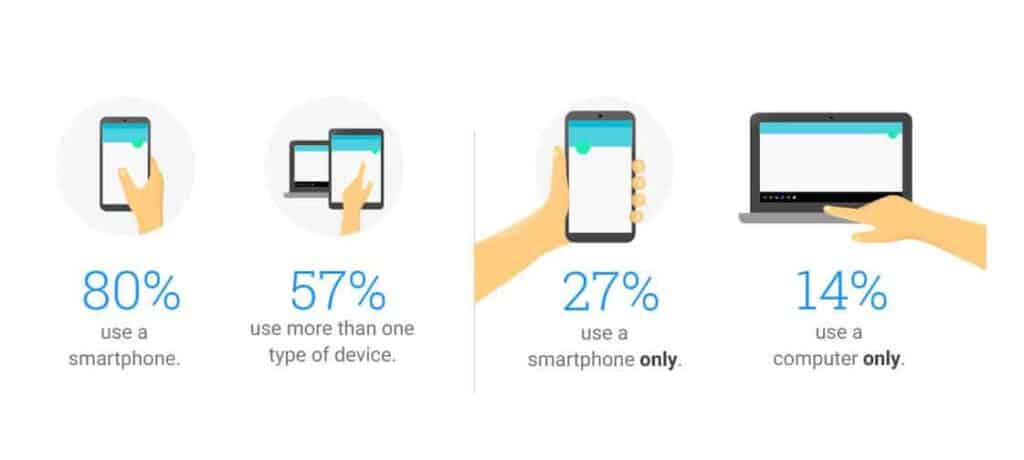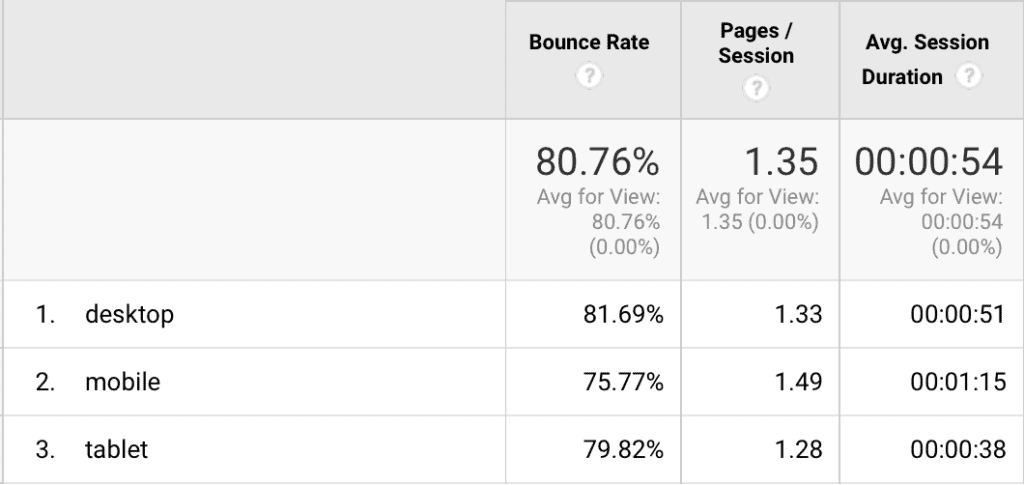Consumers are increasingly finding what they need online.
It’s not just online that’s good enough for consumers anymore though. Mobile consumers are becoming a bigger force every day.
When you’re at a store looking for a new pair of shoes, do you buy the pair you like at the first store you find them?
Or, do you whip out your smartphone and start looking for the same product at other stores or even online?
Does it matter that you found the pair of shoes at one store so you’re not allowed to look at another? Of course not!
If this behavior sounds like yours, you’re not alone.
According to Google/Purchased Digital Diary you’re in a group of 69% of smartphone owners who turn to mobile search first in the moment of need.
Mobile is only part of the story though. Locating the actual point of need consumers find you is the goal. With that knowledge, you can reach more people and give them a better experience with your business.
Locating The Point of Need
Finding consumers that you’re targeting at their point of need will help you target your website for their circumstances.
What are the different ways that consumers are finding your business though?
When you understand the points of need that mobile consumers might experience then you become ahead of the game.
They could find you and/or research your small business in any mix of the following three ways online. Often consumers will move seamlessly between all three also.
Smartphone
The smartphone is the most used single device out of all three ways for a consumer to find you.
There are people who use only the computer and only the smartphone.
For the most part, people use a combination of them both plus a tablet to a lesser extent.

As you can see a lot of people are using a smartphone, more than any other group of mobile device users.
If 80% of consumers use a smartphone you’d better be reaching them appropriately.
I say appropriately because it’s common for websites to not be properly accessible on mobile.
Many websites work on mobile today but there’s a bigger issue than that.
Speed.
Google says that speed is extremely important for your website and that’s even more true for smartphone users.
Tablet
Speed isn’t as much of an issue for the tablet audience because of where tablets are often used.
While a tablet is considered a mobile device, it’s used mostly in the same place a computer is, at home on a fast Wi-Fi internet connection.
Having a website that works well on a tablet is also important because tablets can be used for shopping and researching companies.
A mobile consumers journey may begin on a tablet or computer and end on their smartphone or vice versa.
This is part of the reason why a mobile website that looks the same and works the same on all devices is so important. People move fluidly from smartphone to tablet and even to a computer.
Because mobile consumers are so fluid in how they use devices, how well any given device converts is irrelevant.
Computer
While a computer isn’t technically a mobile device, even a laptop, it still plays a big part in the mobile consumer’s journey.
Because more than 57% of online users use more than one type of device, the computer still plays a large part for mobile consumers.
Not only that but according to the above image, 14% of online users are computer only users. That’s still a large number of people.
Some mobile consumer’s journey ends on the computer which could be a reason why computers sometimes end up with one of the best conversion rates.
Research may start on a mobile device casually but as interest gets more serious more details are needed. With the need for more details and research, a computer becomes a natural step in the conversion. It also ends up being the last step.
I often find myself doing research about a product on my phone while lounging on the couch while my computer is upstairs. As my interest and journey progress, I may head upstairs to grab my computer to get into details more.
Locating a consumers point of need for your web page and product or service is all about understanding their journey.
Understanding the stats and the different ways people use these three types of devices helps you reach mobile consumers better.
Mobile Potential
There’s a lot of potential for growth in mobile for small businesses online. Many sites don’t properly focus on mobile, therefore, are leaving a lot of money on the table.
Whether mobile consumers are using a directory like Yelp or searching on their mobile device, the numbers of those users are huge.
It’s not hard to find stories on the internet about people not seeing good returns from mobile users.
Mobile consumers are typically seen to have a lower conversion, higher bounce rate, and less time on pages.
That, of course, is anecdotal evidence and it, unfortunately, doesn’t take into account to the reality of how websites treat the mobile internet.
Even with mobile traffic growing and becoming an important part of consumption on the internet, mobile still treated as a second-class citizen on many websites.
I visit websites on my mobile phone every day and find that most of them are sluggish and take a long time to load. Not only that but they require so many resources from my smartphone it may take up to a minute for a page to fully load before I can smoothly scroll.
That, of course, is anecdotal evidence also but it does illustrate the disconnect between how people see mobile consumers and the reality they’re dealing with on the internet.
Mobile Done Right
For a well designed mobile website, there should be no or very little difference in the conversion from desktop to mobile. Not only that but the bounce rate and time on the page shouldn’t be much different either.
If I look at the past year for my website, mobile hasn’t done badly at all. Mobile does play a much smaller role on my website than most but it still shows a clear trend for how mobile should work.

Even though mobile plays a small part in my traffic, mobile still plays a large part in how well my website performs because it increases brand awareness and improves the consumer experience.
Mobile Search
Mobile search is increasing in importance as mobile gains popularity. Google is also playing a role in promoting the growth of the mobile web.
Trends are showing that mobile is an effective way to bring mobile consumers to your business whether online or offline.
According to Google/Purchased Digital Diary, 76% of people who search for something nearby will make their way to at least one of businesses they found within the day. Not only that but 28% of those searchers will actually buy something!
If you don’t have a mobile plan for how and how well you’re reaching mobile visitors, your brand will fall behind online.
Even local consumers are moving towards finding local businesses online so you need to be ready to capture those local mobile consumers.
Mobile Consumers Buy
If you’ve been reading this whole post you’ll have already seen the power of mobile consumers and how they buy.
Even if their journey ends on a desktop, the most important discovery phase might have begun on a smartphone.
If you have a small business online presence then you’re more likely to reach mobile consumers who are ready to buy.
With a more extensive online presence including a mobile-friendly website, you’ll reach even more people. A mobile-friendly website with constantly updated fresh content that gives people a reason to visit is even better.
Your Business, Mobile
Growing a small business from nothing in the age of the internet requires you to have a web designer who design with purpose.
Even when you meet people at events there’s an expectation that they can learn more about you and your business online.
Not only that but you don’t know where consumers are going to research or find your business from. They could find you from a smartphone, tablet, computer, or anything else in between.
Making yourself and small business available everywhere will help expand your online presence to reach consumers who are ready to buy.



